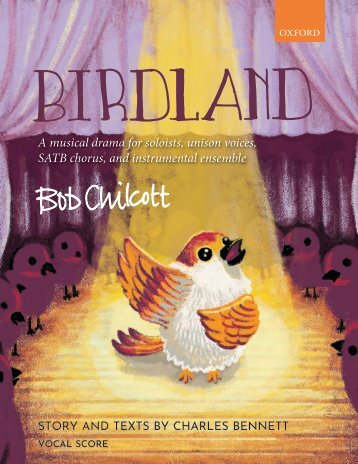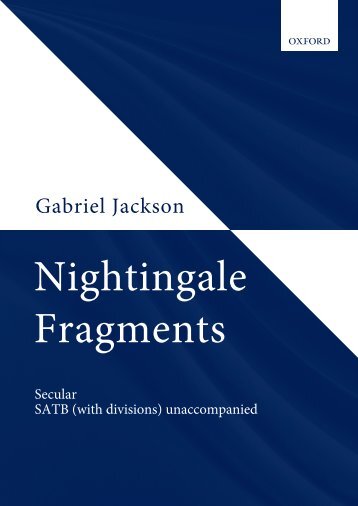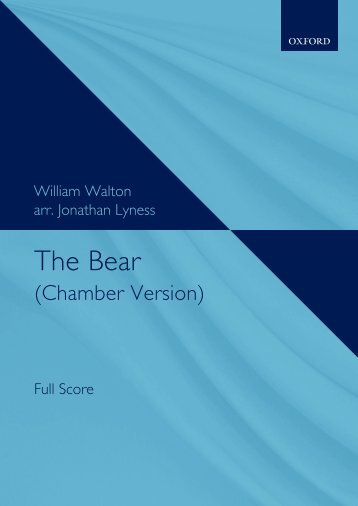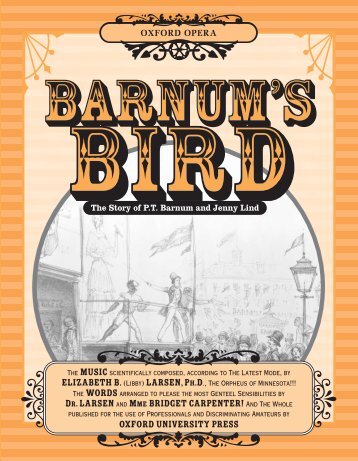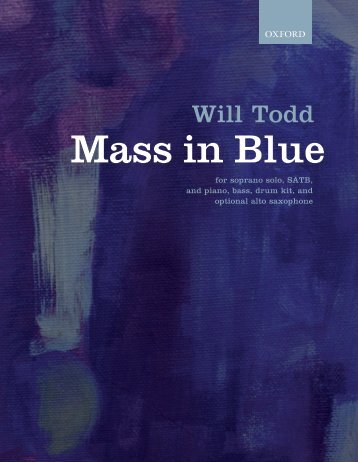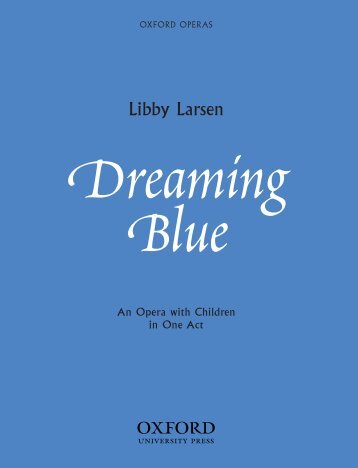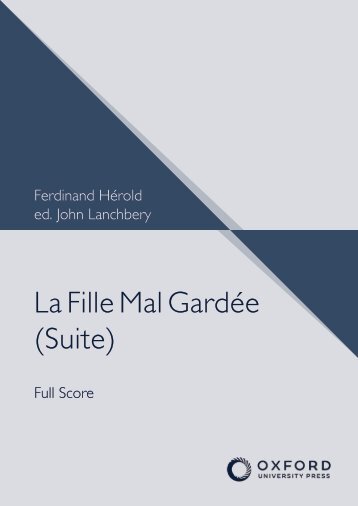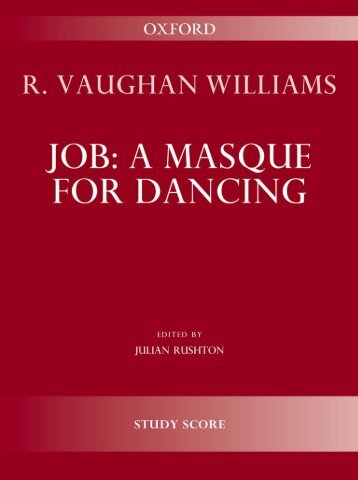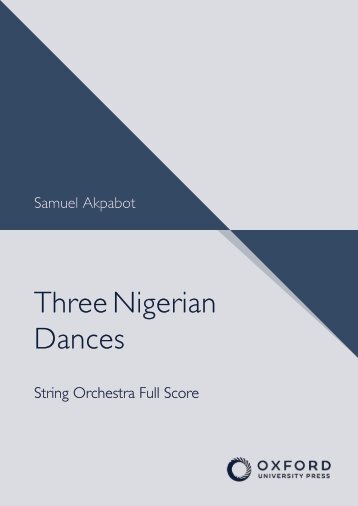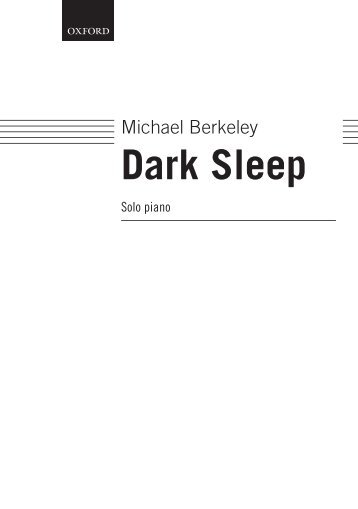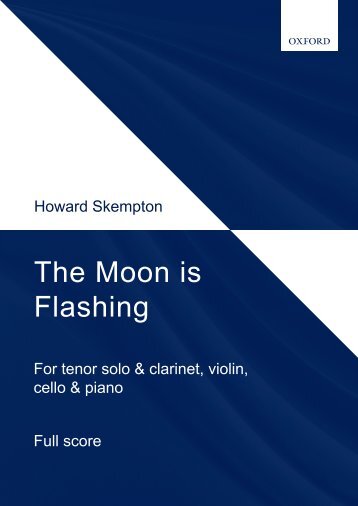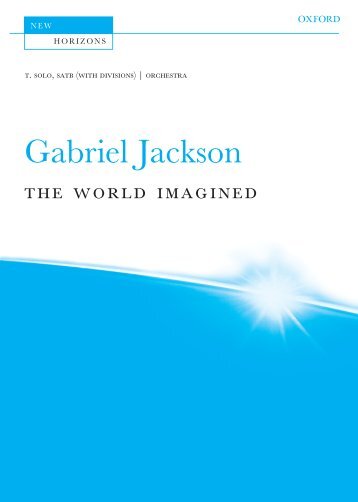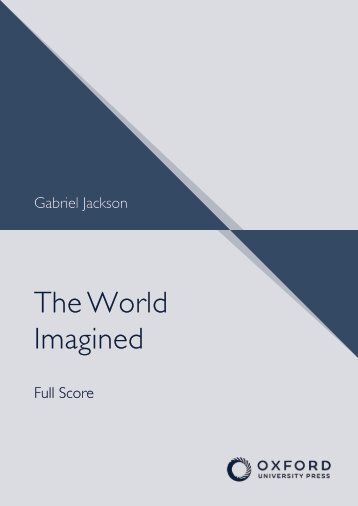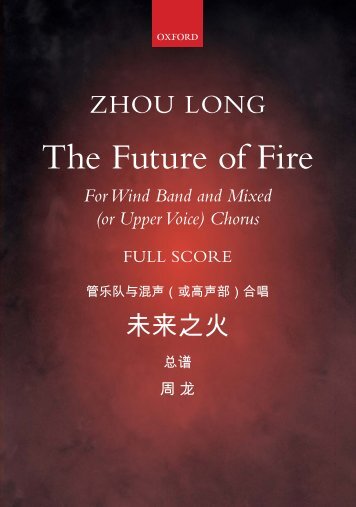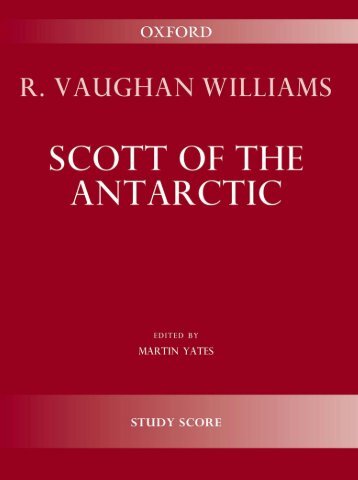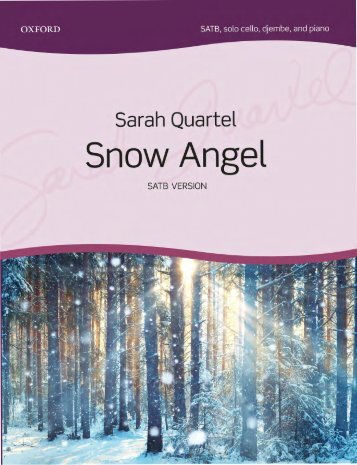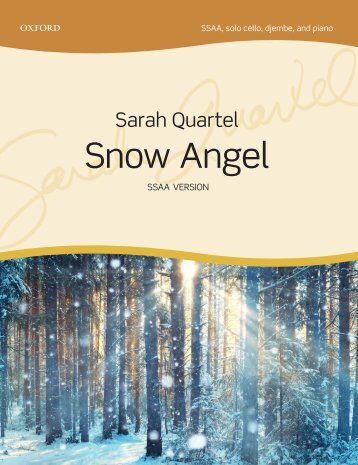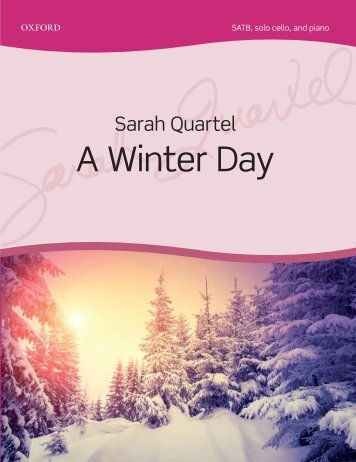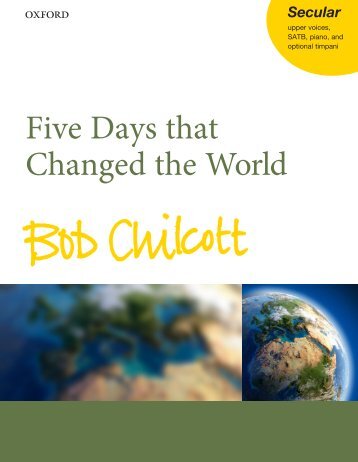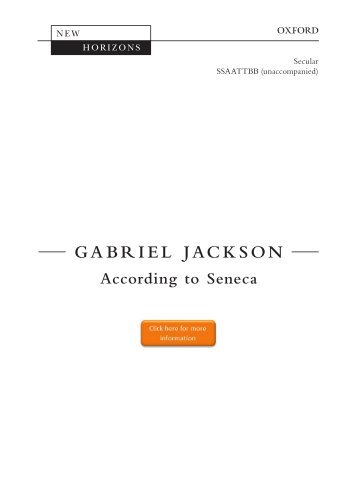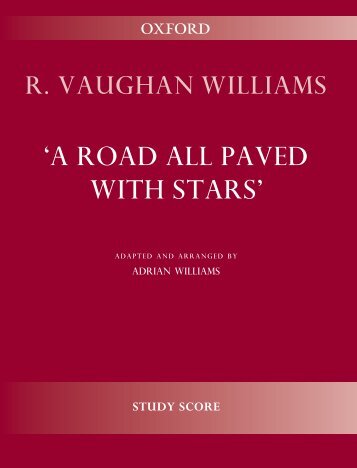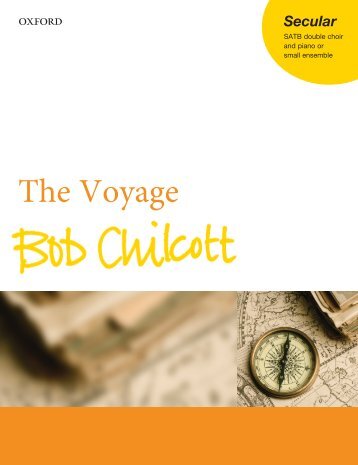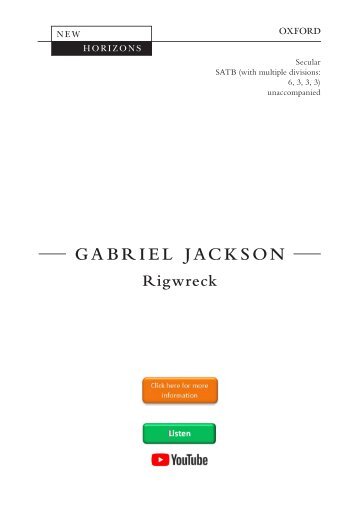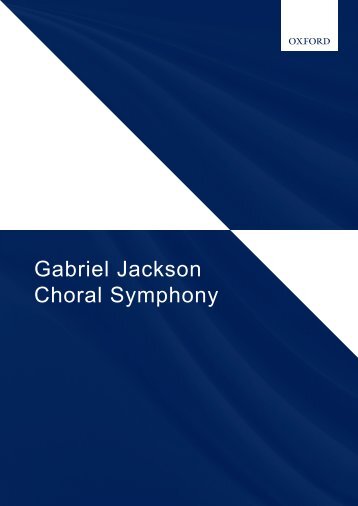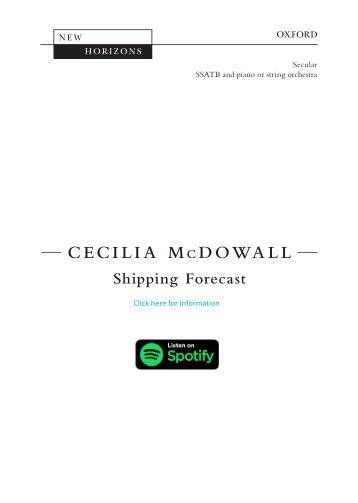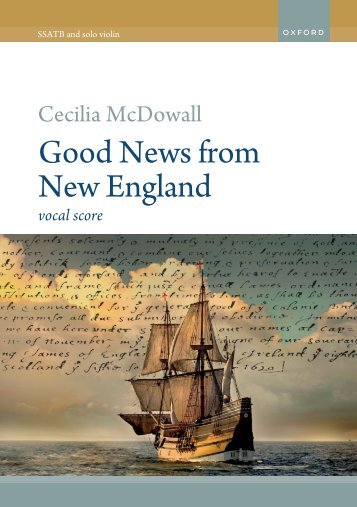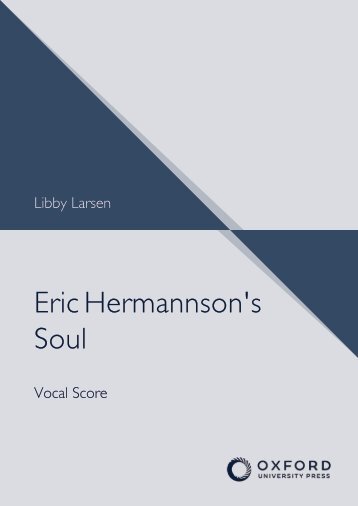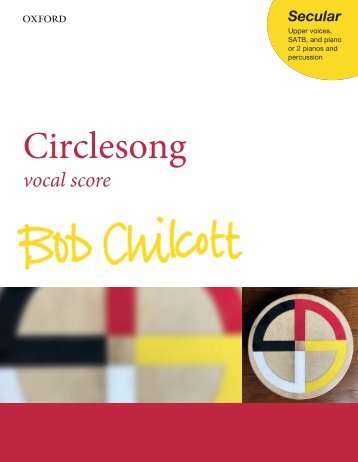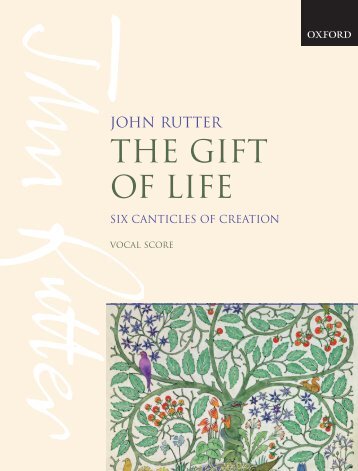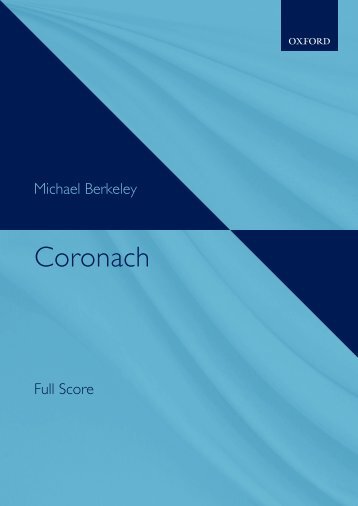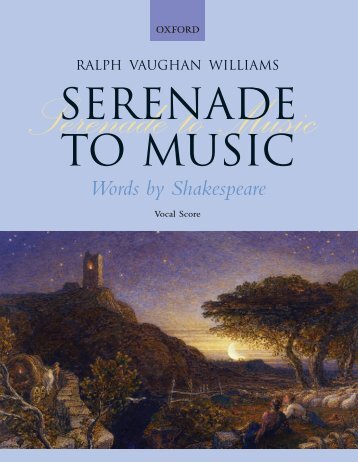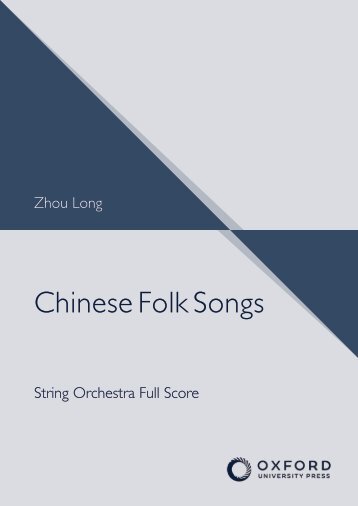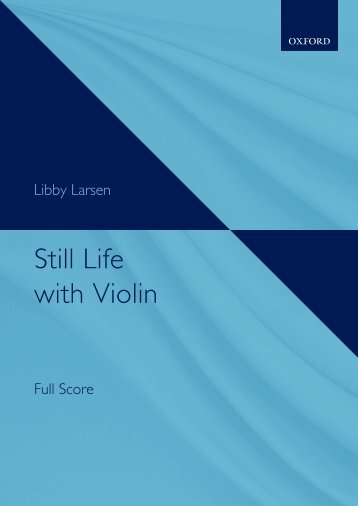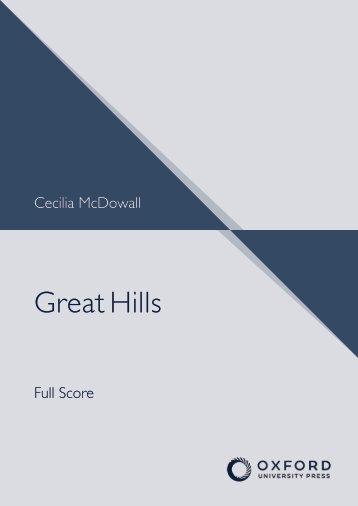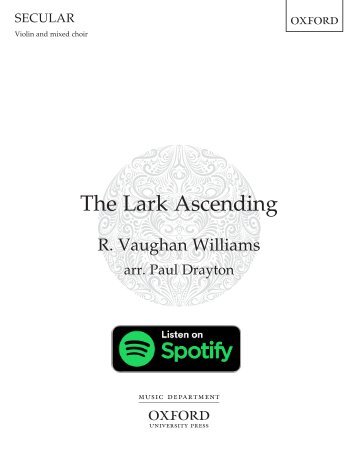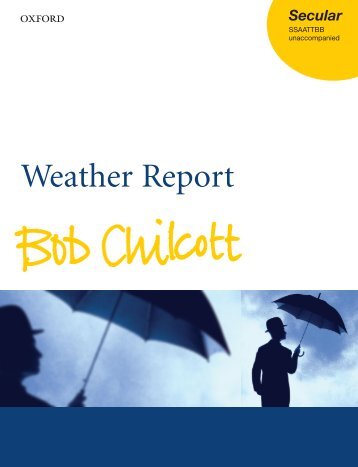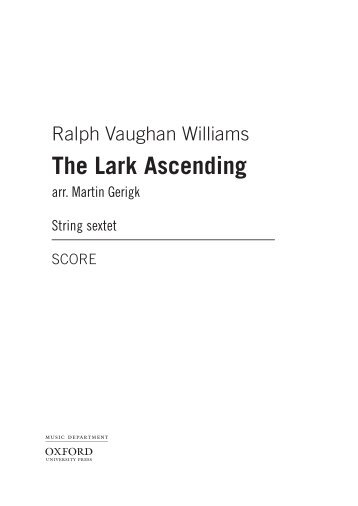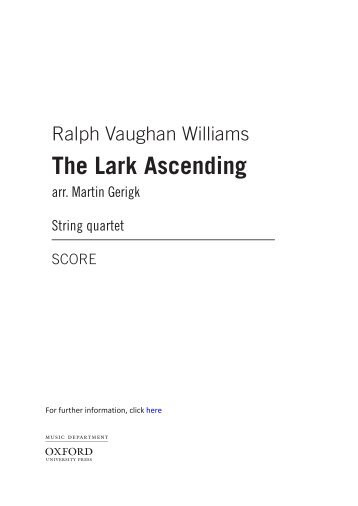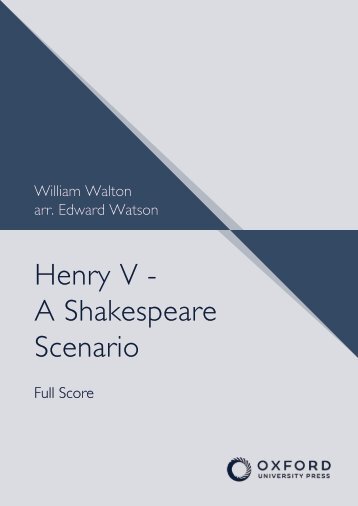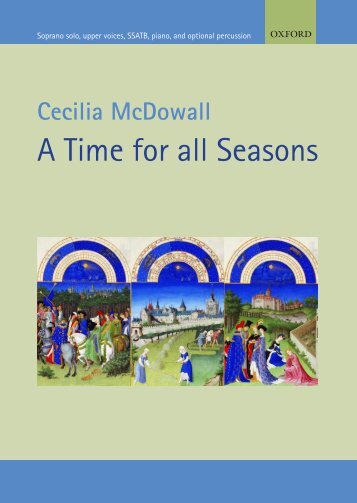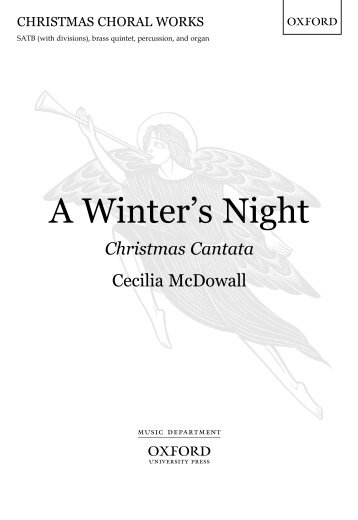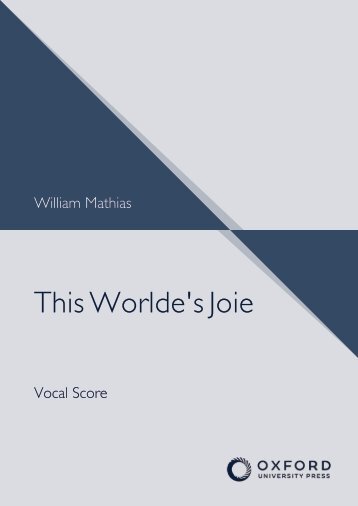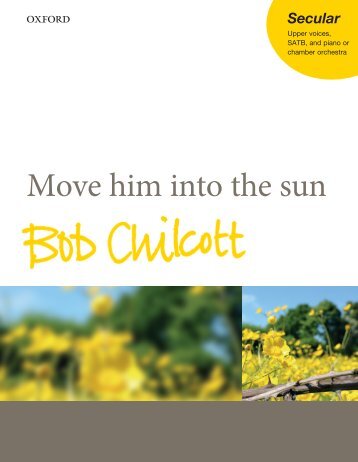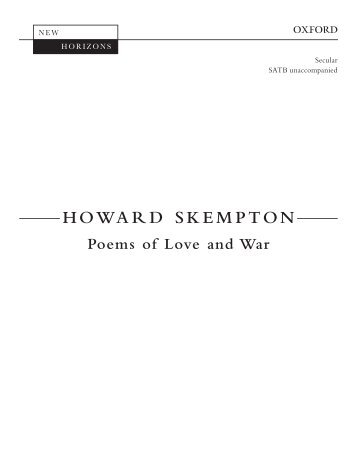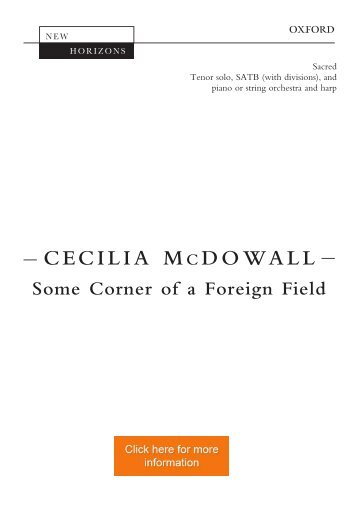
Oxford Programming by Theme
Oxford University Press is proud to publish musical works by some of the most significant composers of the 20th and 21st centuries, with a catalogue that includes a broad range of choral, orchestral and chamber music.

Themes
Select a theme from the list below to view playlists and perusal scores.
- Animals
- Colours
- Dances
- Day and Night
- Elements: Earth
- Elements: Fire
- Elements: Ice
- Elements: Water
- Historical Figures
- Journeys and Transport
- Life and Death
- Light and Dark
- Music about music and sound
- Myths, Legends, and Folktale
- Nature
- Royalty and Ceremony
- Rivers and Oceans
- The Seasons
- War and Conflict
R. Vaughan Williams - Job: A Masque for Dancing
- Text
- Orchestra
- Ballet
- Rushton
- Job
- Williams
- Oxford
- Oup
ass clarinet,
ass clarinet, contrabassoon, 3rd trumpet. Lambert’s reduction greatly reduces the wind contingent (see Sources). Vaughan Williams named the flute in G ‘Bass flute’; this edition adopts the normal nomenclature, alto flute, and specifies the Eb saxophone as ‘alto’, as is clearly the composer’s intention. In Scene VI, the saxophone solo is cued on flute and clarinet staves. Lambert’s reduction has the following note (addressed to the copyist): The saxophone part may be played in three ways: (1) By an extra player. (2) By the 2nd clt. player. (3) By the 1st flute / 1st clt. / bassoon in unison. Vaughan Williams’s full score cues passages too low for the flute into clarinet and bassoon, and those too high for the bassoon into flute and clarinet. The preferred substitution when a saxophone is not available seems to be two instruments in unison, but the sources do not make this clear, merely suggesting that the saxophone ‘may be played by the bass clarinet player’; in that case its earlier entrance (Scene IV, fig. 29) is omitted, as the bass clarinet is also active at that point. For the contrabassoon Vaughan Williams suggests several higher alternatives, presumably for instruments not extending a whole octave below the bassoon. The lower pitches are clearly what the composer wanted. For the horns, Vaughan Williams distinguished between mutes and stopped notes, the latter of which, when loud, imply the harsh bouché effect, cancelled by ‘open’ or ‘naturale’. Scene I, bar 80 presents a puzzle: although he cancelled the notes given to trumpets 1 and 2 (see Sources), he marked trumpet 3 ‘solo’. Trumpet 3 is cued for flute, despite the other trumpets becoming available. Percussion Accustomed to kettle drums, Vaughan Williams notated timpani pitches on prefatory staves for each scene, and indicated retuning within scenes. These markings, redundant for pedal timpani, are omitted in this edition. He sometimes requires the timpanist to use wooden sticks, cancelled by ‘naturale’.The autograph contains several deletions in the percussion, in response to Holst, at the first orchestral rehearsal, ‘almost going on his knees to beg me to cut out some of the percussion with which my inferiority complex had led me to overload the score’ 20 (see Appendix 2). Organ Scene VI, from fig. 37, where Satan is revealed seated on God’s throne, Vaughan Williams noted in the score: ‘Where there is an Organ with very powerful reeds the bars marked Ø may be played by Organ and Timpani only’. The passages marked are midway through bar 72 (the tam-tam stroke on the first beat should remain), and bars 73 and 76. Prior to the performance at the Three Choirs Festival in 1931, Vaughan Williams asked Herbert Sumsion: Is there an organ in the Town Hall at Gloucester? And if so has it got some very loud and raucous reeds? There are 4 bars of ‘Job’ which ought to be organ solo, but I have not yet found an organ loud enough or unpleasant enough to do them justice. 16 Harps Vaughan Williams did not note pedal changes, but took care to make them possible, hence his occasional enharmonic notation (e.g. B# for C). for online perusal only Strings For Scene I, a footnote in the printed score directs the contrabasses to ‘Divide in the proportion of 1 player on upper part to 3 on lower part’. In Scene II, the solo viola is marked ‘poco vibrato’. Given that Vaughan Williams had recently worked with Lionel Tertis (who played the solo part in the premiere of Flos Campi), it is possible that this is intended to reduce the amount of vibrato, rather than increase it. Metronome marks On the first bar, the printed score had a footnote: ‘The metronome marks are approximate’. In Scene VIII, at bar 97, autograph markings (in pencil) read q = 76 (as in the printed score), and q = 80 and ‘= Pavane’. In the printed score, the ‘Altar Dance’ is at fig. 76, whereas the ‘Pavane’ (Scene VII, bar 62) is q. = 80. The Pavane returns at the combination of themes (bar 127), which could justify a slight increase of speed at this point. Acknowledgements I am grateful to Hugh Cobbe for suggesting I undertake this revision of Job. I would also like to thank the staff at OUP; the British Library, which kindly made the autograph score available; and Adrian Brown, who supplied some annotations made by Boult, with whom he studied. Julian Rushton Golcar, May 2018 20 National Music, p. 194. 21 Unpublished letter, kindly communicated by Hugh Cobbe. vii
sources Manuscript Autograph Score Holograph full score Add. MS 54326 British Library, London Bound by the library. On the spine: ‘Presented by Sir A. Boult’. Ink, with conductor’s marks in blue crayon (not corrections, but reminders for cueing instruments, or changes of tempo). Various foliations and paginations. The score was used to prepare the printed full score (P). Outer wrapping: ‘Job / Full score / R. Vaughan Williams / The White Gates / Dorking’. On the verso is a list of the orchestral instruments in pencil. The next leaf has a printed title page pasted on, evidently a proof for the title of the printed score; ‘Illustrations to of the Book of Job’ is corrected by hand. The page is signed ‘R. Vaughan Williams / The White Gates / Trescott Road / Dorking’. Verso blank. The MS is interspersed with reproductions of the Blake engravings, pasted onto pages containing one to four images, many marked ‘NO’, with ‘not to be engraved’ on each page. The music is written on 28-stave paper. Stave lines have faded, in places to near-invisibility, but the music is clearly written. The MS does not contain the synopsis that was included in the printed full score, but the scenes are marked at the same points. Most of the stage-directions are printed, no doubt cut out of the proof copy of the printed score. Some shorter directions were entered by the composer in ink, as was one supplement to a printed direction, perhaps following an accident with the scissors. The only longer handwritten direction is in Scene VI, beginning ‘Job stands and curses God’. The MS shows many signs of revision. Several changes were substantial enough for the composer to recopy the music on leaves pasted over the original readings. Only one such leaf has become detached (covering Scene IV, bars 79–81; see Appendix 2). Most pasted-on leaves cover whole pages, but for some (e.g. Scene 1, bars 13–19) only a section is revised (in this case woodwind). Others are strips of manuscript paper pasted over a single bar. A few passages are crossed through in blue crayon with the word ‘OUT’. These cuts, possibly made after the first performance(s), preceded the first stage performance; these passages are not in the reduced score prepared by Constant Lambert (see Appendix 1). Some revisions are in pencil; in Scene IV, the metronome mark was added later and some of the bowing is in pencil. Cues to replace instruments that may not be available are in red ink, and (with a few minor exceptions) appear in small notes in the printed score, and in this edition. Red ink was also used for minor corrections and deletions. Some revisions lighten the orchestration, e.g. Scene I, bar 80, where originally Trumpets 1 and 2 doubled solo Viola and Trumpet 3. The percussion (especially cymbals, triangle, and side drum) was lightened in several places, presumably after hearing the work (and on Holst’s advice; see Preface and Appendix 2). Verbal comments on the score include the instruction, in Scene II, bars 21–8, to notate the bassoons enharmonically, in flats, although they are doubling strings notated in sharps. Editions for online perusal only Printed Full Score London: Oxford University Press, 1934 Dedicated to Adrian Boult. Title page: ‘JOB / A Masque for Dancing / [ornamental *] / Founded on / Blake’s / “Illustrations of the Book of Job” / By Geoffrey Keynes and / Gwendolen Raverat / Music by R. Vaughan Williams / Full Score / Oxford University Press / 36 Soho Square Oxford Street London W.1 / New York—Carl Fischer Inc. / Paris—Le Magasin Musical Pierre Schneider / Amsterdam—Broekmans & Van Poppel / Lausanne—Foetisch Frères S.A.’ Overleaf: NOTE / The Music of Job was first performed in concert form at the Norwich Festival, 1930. The first stage performance was given by the Camargo Society at the Cambridge Theatre, London 1931. Choreography by Ninette de Valois. Scenery and dresses designed by Gwendolen Raverat. Musical Director, Constant Lambert. The music is scored for full symphony orchestra, but a version for small theatre orchestra has been made by Constant Lambert. Information as to scenery and dresses for Job can be obtained from Mrs Raverat, c/o Oxford University Press. Orchestral material may be hired from the Publishers, to whom also all applications for performances should be made. The next leaf contains the orchestration and on the verso is the synopsis, preceded by this note: The following synopsis and the more detailed scenario printed with the music differ in some particulars from the original scheme of the authors. For these alterations the composer alone is responsible. Piano Arrangement London: Oxford University Press, 1931 Piano reduction by Vally Lasker, made for rehearsal purposes, and the first version of Job to be published. Price 5s, raised in 1956 to 7s 6d. Frontispiece: Blake engraving ‘Hast thou viii
- Page 2 and 3: . VAUGHAN WILLIAMS for online perus
- Page 4 and 5: Contents Preface page v Sources Tex
- Page 6 and 7: preface The conception of Job was a
- Page 10 and 11: considered my servant Job?’. Titl
- Page 12 and 13: 106/75-7 Cl.: no tenutos in aut 106
- Page 14 and 15: Vln. I Vla. Vcl. B.Cl. A.Sax. Bsn.
- Page 16 and 17: Fl. Ob. C.A. Cl. (Bb) B.Cl. Bsn. Cb
- Page 18 and 19: Fl. Ob. 1 2 3 1 2 5 ° & bb & bb œ
- Page 20 and 21: Job a masque for dancing for online
- Page 22 and 23: Flutes Alto Flute Oboes Cor Anglais
- Page 24 and 25: 3 Here the distant landscape lights
- Page 26 and 27: 5 Fl. A.Fl. 1 2 19 p a 2 3 3 take F
- Page 28 and 29: 7 Fl. C.A. Cl. (Bb) B.Cl. 43 ’ 3
- Page 30 and 31: 9 Fl. Ob. C.A. 1 2 3 1 2 72 Job sta
- Page 32 and 33: Fl. A.Fl. Ob. C.A. Cl. (Bb) B.Cl. B
- Page 34 and 35: 13 Fl. 1 2 88 stringendo 5 Satan ap
- Page 36 and 37: 15 Fl. 1 2 110 6 p Saraband of the
- Page 38 and 39: 17 Fl. 1 2 3 128 pp 8 God arises in
- Page 40 and 41: 19 Picc. Fl. Ob. C.A. Cl. (A) B.Cl.
- Page 42 and 43: 21 Picc. Fl. Ob. C.A. Cl. (A) B.Cl.
- Page 44 and 45: Picc. 171 10 23 Fl. Ob. 1 2 1 2 C.A
- Page 46 and 47: Scene II Satan’s Dance of Triumph
- Page 48 and 49: 27 Picc. 23 p Fl. Ob. 1 2 1 2 p p C
- Page 50 and 51: 29 Picc. 40 ff ff dim. pp Fl. Ob. C
- Page 52 and 53: 31 Picc. 57 ff Fl. 1 2 a 2 ff Ob. 1
- Page 54 and 55: Picc. Fl. Ob. C.A. Cl. (A) B.Cl. Bs
- Page 56 and 57: 35 Picc. 92 f Moderato alla marcia
- Page 58 and 59:
37 Picc. Fl. Ob. 1 2 1 2 107 a 2 a
- Page 60 and 61:
39 117 18 Satan climbs up to God’
- Page 62 and 63:
41 Picc. 137 19 2 2 2 fff Satan kne
- Page 64 and 65:
43 157 The hosts of Hell enter runn
- Page 66 and 67:
Scene III Minuet of the Sons of Job
- Page 68 and 69:
Fl. Ob. C.A. Cl. (A) B.Cl. Bsn. Hrn
- Page 70 and 71:
Picc. Fl. Ob. C.A. Cl. (A) B.Cl. Bs
- Page 72 and 73:
51 65 Picc. pp fff Fl. 1 2 pp a 2 f
- Page 74 and 75:
53 Picc. 83 dim. 2 pp take Fl. 3 2
- Page 76 and 77:
Scene IV Job’s Dream 55 Violin I
- Page 78 and 79:
Picc. 33 26 57 Enter Satan. Tableau
- Page 80 and 81:
59 45 27 Enter Famine. Picc. p pp F
- Page 82 and 83:
61 58 28 Enter Battle, etc. Picc. 3
- Page 84 and 85:
63 Picc. 68 ff Fl. Ob. 1 2 1 2 ff f
- Page 86 and 87:
65 77 29 Picc. Fl. Ob. 1 2 1 2 a 2
- Page 88 and 89:
67 84 30 The vision gradually disap
- Page 90 and 91:
Scene V Dance of the Three Messenge
- Page 92 and 93:
71 Fl. 1 2 20 p 3 3 3 p 3 3 Ob. 1 2
- Page 94 and 95:
73 Ob. 1 2 36 Lento C.A. Cl. (Bb) 1
- Page 96 and 97:
Scene VI Dance of Job’s Comforter
- Page 98 and 99:
77 Picc. 18 34 Poco più mosso f p
- Page 100 and 101:
79 26 Picc. Fl. Ob. 1 2 1 2 a 2 f f
- Page 102 and 103:
34 Here the comforters return to th
- Page 104 and 105:
Picc. 46 36 Andante maestoso (h = 6
- Page 106 and 107:
85 Fl. Ob. C.A. 1 2 3 1 2 60 a 2 [a
- Page 108 and 109:
87 74 Picc. ff 3 Fl. 1 2 p p ff 3 p
- Page 110 and 111:
89 1 85 3 The vision gradually disa
- Page 112 and 113:
91 19 38 * Hp. 1 pp 6 6 38 Vln. I 3
- Page 114 and 115:
93 Cl. (A) 1 2 50 2 Rit. in tempo I
- Page 116 and 117:
95 Fl. 1 2 68 pp 40 3 pp C.A. pp Cl
- Page 118 and 119:
97 Fl. Ob. 1 2 3 1 2 80 cresc. f 3
- Page 120 and 121:
Piccolo Flutes Oboes Cor Anglais Cl
- Page 122 and 123:
101 Fl. Ob. C.A. Cl. (Bb) B.Cl. 1 2
- Page 124 and 125:
103 Fl. Ob. 1 2 3 1 2 39 C.A. Cl. (
- Page 126 and 127:
105 60 45 Picc. ff p f p Fl. Ob. C.
- Page 128 and 129:
81 rit. Here Satan falls out of Hea
- Page 130 and 131:
109 Picc. 97 Altar Dance Curtain ri
- Page 132 and 133:
111 Fl. 1 2 3 117 4 4 take Picc. 2
- Page 134 and 135:
113 Picc. 132 pp Fl. Ob. C.A. 1 2 1
- Page 136 and 137:
115 Picc. 142 pp 50 4 pp cresc. 3 3
- Page 138 and 139:
Scene IX Epilogue 117 Flutes Alto F
- Page 140 and 141:
119 Fl. 1 2 12 3 Enter gradually Jo
- Page 142 and 143:
121 Fl. 1 2 22 BLANKED OUT SECTION
- Page 144:
for online perusal only
Inappropriate
Loading...
Mail this publication
Loading...
Embed
Loading...

